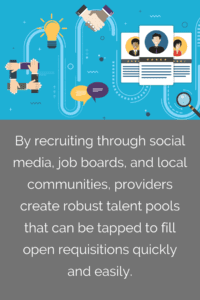Using a managed direct sourcing approach, one company was able to grow its talent pools and improve the candidate experience.
By Marta Chmielowicz
When the home improvement industry surged during the height of the COVID-19 pandemic, one company found that it could not meet its production demand. The organization was losing talent and struggled to fill critical roles in its rural locations.
Geometric Results Inc. (GRI) stepped in to help, revamping its client’s permanent talent acquisition strategy to align with a managed direct sourcing approach. The result?
- In the first 30 days, the size of the company’s talent community increased by 250%, with 4,000 candidates added through a digital and local outreach campaign.
- Candidate engagement scores increased, dropping the candidate-to-hire ratio from 13:1 to 3:1.
- Thanks to local grassroots marketing, brand recognition increased. The company is now known as a great place to work, with eight out of 10 candidates recognizing the brand -up from an initial two out of 10.
What is Managed Direct Sourcing?
Managed direct sourcing is a talent acquisition approach that focuses on using technology to cultivate an open-source ecosystem of engaged candidates. By recruiting through social media, job boards, and local communities, providers create robust talent pools that can be tapped to fill open requisitions quickly and easily. Artificial intelligence (AI) and machine learning technologies then monitor each candidate’s engagement to automatically match the candidate with open jobs.
 “On average, we can have upwards of 400 to 500 candidates coming into the talent community for each location,” says Jen Torres, vice president of MSP growth at GRI. “From there, the tool monitors their engagement scores and automatically matches them with open jobs. If the job does not match a candidate’s particular background or timeline, we either advance them to other types of jobs within that company or we redeploy them into other talent communities.”
“On average, we can have upwards of 400 to 500 candidates coming into the talent community for each location,” says Jen Torres, vice president of MSP growth at GRI. “From there, the tool monitors their engagement scores and automatically matches them with open jobs. If the job does not match a candidate’s particular background or timeline, we either advance them to other types of jobs within that company or we redeploy them into other talent communities.”
This solves the biggest challenge experienced by recruiters -keeping promising active and passive candidates engaged and interested in future opportunities. Using this solution, job seekers encounter frequent touchpoints that gauge their interest, match their communication preferences, and maintain a high-touch, personalized hiring experience.
“This is the biggest point of failure and loss with traditional RPO models,” explains Mike Wachholz, CEO of GRI. “In a human-driven recruiting system, if candidates aren’t onboarded, recruiters have historically been ineffective at keeping them warm. There’s a huge drain and missed opportunity in legacy models. This model helps close that gap and helps companies maximize their investment in time and energy.”
Which Companies can Benefit Most From This Approach?
While managed direct sourcing can deliver tangible benefits to any company, its unique approach is particularly well suited to organizations facing particular hiring challenges.
- Competitive industries. Companies in high-demand industries, like industrial, manufacturing, and logistics, that are struggling to find candidates with needed skill sets would benefit from the expanded talent pools of a direct sourcing approach.
- High volume hiring. Organizations that hire a high volume of employees at certain points of the year, such as benefits and insurance companies, are often unprepared to cope with the influx of talent. Using a direct sourcing solution, they can remain agile in the face of shifting talent needs.
- Niche skill sets. “There are some industries, like tech and aerospace, that are looking for candidates with really niche skill sets and credentials. The hundreds of thousands of companies that are not as known in the market struggle to compete for these individuals,” says Torres. For these companies, a high-touch direct sourcing approach can build brand recognition and get candidates in the door.
- Limited geographic markets. Sometimes, geographic limitations create hiring challenges that can be hard to beat. “You’ve got these tertiary markets where companies need to educate the marketplace on their brand, culture, why they’re a great place to work -and then develop the talent pools. They may be the brand of choice, but they have to develop that brand affinity,” says Wachholz. “This is a really interesting model for companies moving into new geographies or developing new products or solutions. It’s elevating their unique story to candidates.”
By nurturing a community of workers through a managed direct sourcing solution, organizations can ensure that they stay ahead of the competition and meet their shifting talent goals today and tomorrow.














